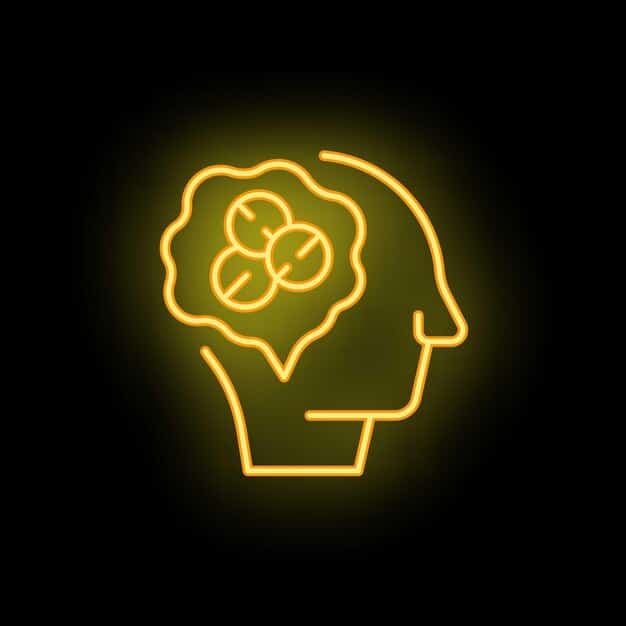Develop a Growth Mindset: Unlock Your True Potential

Developing a growth mindset involves cultivating the belief that one’s abilities and intelligence can be developed through dedication and hard work, fostering a love of learning and resilience crucial for overcoming challenges and achieving personal and professional growth.
In a world characterized by constant change and evolving demands, the concept of a static intelligence or inherent talent is increasingly challenged. To truly thrive and adapt, individuals are encouraged to develop a growth mindset: embrace challenges and unlock your potential, recognizing that our capabilities are not fixed but can be expanded through effort and persistence. This perspective offers a powerful framework for personal growth, resilience, and sustained achievement in all aspects of life.
Understanding the Growth Mindset: A Foundational Shift
The concept of a growth mindset, popularized by Stanford psychologist Carol Dweck, Ph.D., stands in stark contrast to what she terms a “fixed mindset.” At its core, it’s about believing that your basic qualities, like intelligence or talent, are not simply fixed traits. Instead, they are seeds that can be cultivated and grown through dedication and hard work. This perspective profoundly influences how we approach learning, challenges, and setbacks in life.
For those with a fixed mindset, challenges are often seen as threats to their perceived innate abilities. They might avoid difficult tasks because failure would expose their limitations. Success is attributed to natural talent, and effort is sometimes viewed as a sign of inadequacy. This can lead to a preference for easy wins and a fear of any situation where their intelligence or skills might be tested and found wanting.
The Power of “Yet” in Growth Mindset
One of the simplest yet most profound tools in adopting a growth mindset is the word “yet.” When faced with a difficult task, instead of thinking “I can’t do this,” a growth mindset encourages the thought “I can’t do this yet.” This subtle linguistic shift transforms a statement of limitation into one of potential and future development. It implies that with continued effort, learning, and perseverance, mastery is attainable. This small change can revolutionize how individuals perceive their learning journey and their capacity for improvement.
- Reframes failure: Transforms setbacks into opportunities for learning, rather than definitive endpoints.
- Encourages persistence: Fosters a willingness to try again and again, even when faced with significant obstacles.
- Sparks curiosity: Promotes a desire to explore new strategies and absorb new information.
- Builds resilience: Strengthens one’s ability to bounce back from adversity and embrace the learning process.
Conversely, the growth mindset embraces challenges as opportunities for learning and development. Individuals with this mindset believe that abilities can be developed through effort, good strategies, and input from others. They see effort not as a sign of weakness, but as a pathway to mastery. Failure is not seen as a definitive statement about their inherent limitations, but rather an informative stepping stone, providing valuable feedback on what to try next. This fundamental difference in perspective impacts everything from academic performance to career advancement and personal relationships.
Embracing Challenges as Stepping Stones for Growth
To truly develop a growth mindset, one must fundamentally shift their relationship with challenges. No longer are they obstacles to be avoided, but rather integral components of the learning process, essential for unlocking true potential. This paradigm shift can be difficult, as our natural inclination often leads us to seek comfort and avoid situations that test our limits.
When we encounter a challenge, our initial response might be fear, frustration, or a desire to retreat. However, a growth mindset encourages us to recognize these feelings, acknowledge them, and then reframe them. Instead of seeing the challenge as an external force imposing difficulty, we begin to view it as an internal prompt for expansion. It’s an invitation to learn something new, to refine existing skills, or to discover capabilities we didn’t know we possessed.

Active Engagement and Reinterpretation
Embracing challenges involves active engagement, not passive acceptance. It means analyzing what went wrong, seeking out new information, and being open to constructive criticism. It’s about recognizing that every stumble offers a lesson, every difficult situation presents an opportunity for resilience. Think of a musician practicing a complex piece; the “challenge” of mastering it is what leads to their improved skill and performance. Without seeking out and engaging with these tougher pieces, their growth would stagnate.
- Seek novel experiences: Actively look for situations outside your comfort zone, whether in your personal or professional life.
- Deconstruct failures: Instead of dwelling on what went wrong, analyze the contributing factors and identify actionable steps for improvement.
- Learn from feedback: View criticism not as a personal attack, but as valuable data points guiding your development.
- Celebrate small victories: Acknowledge progress, no matter how incremental, to reinforce the positive correlation between effort and growth.
Moreover, embracing challenges helps us build resilience. Each time we push through a difficult situation, we strengthen our mental fortitude and develop a deeper sense of self-efficacy. This cumulative experience teaches us that we are capable of overcoming adversity, equipping us with the confidence to tackle even more significant hurdles in the future. It’s a virtuous cycle: the more challenges we embrace, the more capable we become, and the more potential we unlock.
The Role of Effort and Deliberate Practice
In a society that often glorifies innate talent, the concept of effort can sometimes be undervalued. However, within the framework of a growth mindset, effort is not simply about working hard; it’s about deliberate, strategic effort. This distinction is crucial because simply putting in hours without focused attention will not necessarily lead to growth. Deliberate practice, a term coined by psychologist K. Anders Ericsson, emphasizes specific, purposeful efforts to improve performance.
Deliberate practice involves identifying specific areas for improvement, setting clear goals, focusing intensely during practice, seeking immediate feedback, and repeatedly refining your approach. It’s not just about doing the same thing over and over; it’s about constantly pushing the boundaries of your current abilities. For instance, rather than mindlessly playing scales on a musical instrument, a musician engaging in deliberate practice might focus on a particularly challenging passage, identify the tricky notes, slow it down, practice it repeatedly, and then gradually increase the tempo, all while critically evaluating their performance.
Strategic Application of Effort
This kind of effort is often uncomfortable because it requires stepping outside of what is already easy or familiar. It demands sustained concentration and a willingness to confront one’s own limitations. The payoff, however, is substantial. This intentional form of engagement leads to measurable improvements in skill, understanding, and overall competence. It’s what distinguishes true mastery from mere competence.
- Specific goals: Define exactly what you want to improve, rather than just vague aspirations.
- Focused attention: Dedicate your full concentration to the task at hand, minimizing distractions.
- Immediate feedback: Actively seek out and analyze feedback, whether from a mentor, a tool, or self-reflection.
- Repetitive refinement: Continuously adjust and improve your methods based on the feedback received.
Furthermore, recognizing the power of deliberate effort shifts the narrative around “natural talent.” While some individuals may have predispositions or start with certain advantages, it is ultimately consistent, purposeful effort that builds true expertise. This understanding is profoundly empowering, as it means that success is within the reach of anyone willing to put in the necessary work and commitment. It democratizes achievement, emphasizing that diligence, curiosity, and strategic practice are the real drivers of unlocking potential.
Learning from Feedback and Criticism
A cornerstone of developing a growth mindset is the ability to not just receive, but actively seek out and effectively utilize feedback and criticism. For someone with a fixed mindset, critique can be perceived as an attack on their inherent abilities, leading to defensiveness or avoidance. However, for those cultivating a growth mindset, feedback is recognized for what it truly is: invaluable data points for learning and improvement.
The journey of personal and professional development is rarely a linear path. We make mistakes, we encounter areas where our knowledge is insufficient, and our performance can always be refined. Feedback, whether it comes from a supervisor, a peer, a mentor, or even self-reflection, provides crucial insights into these areas. It highlights blind spots, suggests alternative approaches, and confirms what is working well. Without this external mirror, our growth would be significantly limited, relying only on our often-biased self-assessment.
Transforming Critique into Catalysts
To benefit from feedback, it’s essential to cultivate an open and receptive posture. This means truly listening to what is being said, even if it’s uncomfortable, and resisting the immediate urge to justify or explain. Instead, focus on understanding the message, asking clarifying questions, and considering how the feedback can inform your future actions. The goal is not to defend your past performance, but to enhance your future capabilities.
- Seek clarity: Ask follow-up questions to ensure you fully understand the feedback and its implications.
- Separate intent from delivery: Focus on the message itself, rather than getting caught up in how it was delivered.
- Identify actionable insights: Determine what specific steps you can take based on the feedback received.
- Demonstrate receptiveness: Show genuine appreciation for the feedback, even if it’s challenging, to encourage future open communication.
Moreover, developing a strong emotional regulation is key when receiving feedback. It’s natural to feel some discomfort or even defensiveness, but acknowledging these emotions without letting them derail the learning process is a mark of a mature growth mindset. This ability to detach emotionally from the critique allows for objective analysis and the transformation of potentially negative experiences into powerful catalysts for personal and skill development. Ultimately, embracing feedback is not just about getting better at a task; it’s about growing as an individual capable of continuous self-improvement.
Cultivating Resilience Through Adversity
Adversity is an undeniable part of life. Whether it manifests as career setbacks, personal failures, or unforeseen challenges, how we respond to these moments largely defines our path forward. A key component of a growth mindset is the cultivation of resilience—the ability to bounce back from difficult experiences stronger and more capable than before. This isn’t about avoiding pain or disappointment, but rather about developing the mental and emotional fortitude to navigate them constructively.
For someone with a fixed mindset, adversity can be devastating. A failure might confirm their belief in their own inadequacy, leading to self-blame, withdrawal, and a cessation of effort. For them, a setback signifies a permanent limit to their abilities. However, a growth mindset рефреймы these situations. Instead of seeing a failure as an indictment of their core self, they view it as a valuable learning opportunity, a signal to adjust their approach, seek new strategies, or simply try again with renewed determination.

Strategies for Bouncing Back Stronger
Cultivating resilience involves several key practices. Firstly, it requires accepting the reality of the situation without dwelling on blame or regret. This acceptance frees up mental energy that can then be channeled into problem-solving. Secondly, it involves maintaining perspective and remembering that a single setback does not define one’s entire worth or future potential. Thirdly, it means actively seeking solutions and drawing upon internal and external resources, whether that’s learning new skills, seeking advice from mentors, or leaning on a support system.
- Practice self-compassion: Treat yourself with kindness and understanding during tough times, just as you would a friend.
- Reframe narratives: Consciously shift negative self-talk into constructive, growth-oriented thoughts.
- Seek support: Don’t hesitate to reach out to trusted friends, family, or professionals for guidance and encouragement.
- Focus on what’s controllable: Direct your energy towards actions and attitudes you can influence, rather than what you cannot.
Ultimately, a growth mindset sees adversity as a crucible for character development. Each time we navigate a difficult period, we build inner strength, a deeper understanding of our capabilities, and increased confidence in our ability to adapt. This continuous process of overcoming challenges, learning from them, and emerging stronger is what truly transforms potential into demonstrable achievement, enabling individuals to not just survive, but truly thrive in the face of life’s inevitable ups and downs.
Practical Strategies for Nurturing Your Growth Mindset
Developing a growth mindset isn’t a one-time decision; it’s an ongoing practice that requires conscious effort and consistent reinforcement. While understanding the underlying principles is crucial, implementing practical strategies daily is what truly embeds this perspective into your way of thinking and behaving. It requires a shift from passive consumption of information to active application of new habits.
One of the most effective strategies involves paying close attention to your internal dialogue. Our inner voice often reflects our deepest beliefs. By becoming aware of fixed-mindset thoughts—such as “I’m not good enough” or “I’ll never learn this”—we can actively challenge and reframe them. This doesn’t mean ignoring negative emotions, but rather redirecting them towards a more empowering narrative. Instead of “I can’t,” try “How can I?” or “What steps can I take to get closer?”
Developing a Growth-Oriented Daily Routine
Another powerful approach is to seek out learning opportunities in every experience. This could mean asking “What did I learn?” after a challenging meeting, debriefing a failure to understand its root causes, or even observing successful people to understand their strategies. Make learning a continuous journey, not just an event. Embrace curiosity and let it guide you toward new knowledge and skills, actively seeking out resources like online courses, books, or mentors.
- Journaling for reflection: Regularly write down your challenges, efforts, and what you’ve learned.
- Setting learning goals: Focus not just on output, but on what new skills or knowledge you will acquire.
- Surrounding yourself with growth-minded people: Their influence can reinforce your own positive outlook and drive.
- Practicing gratitude for effort: Acknowledge and appreciate the work you put in, not just the outcomes.
Furthermore, celebrate effort and process, not just outcomes. In a fixed mindset, only the final result matters. In a growth mindset, the journey and the effort expended are just as, if not more, important. Praise yourself and others for difficult work, for persistence, and for trying new strategies, regardless of immediate success. This reinforces the belief that genuine growth comes from the process of struggle and perseverance. By consistently applying these daily strategies, you gradually rewire your brain to automatically adopt a growth-oriented interpretation of experiences, making it a natural part of who you are.
From Potential to Proficiency: Sustaining Your Growth
The journey of developing a growth mindset doesn’t have a final destination; it’s a continuous process of evolution and self-improvement. Once you’ve embraced challenges and seen how effort unlocks potential, the next step is to sustain this growth, transforming fleeting moments of insight into lasting proficiency and a consistent trajectory of development. This requires moving beyond initial enthusiasm to strategic planning and long-term commitment.
Sustaining growth means regularly reflecting on your progress and identifying new areas for development. It’s about maintaining a thirst for knowledge and never becoming complacent with your current abilities. This involves a proactive approach to learning, whether through formal education, professional development, or self-directed study. The world is constantly changing, and what was proficient yesterday might be obsolete tomorrow. A growth mindset ensures you remain agile and adaptable.
The Continuous Cycle of Learning and Application
An effective strategy for sustained growth is to become a teacher or mentor. Explaining concepts to others reinforces your own understanding and often reveals gaps in your knowledge that you then feel compelled to fill. It also creates a positive feedback loop, as helping others grow further solidifies your own growth-oriented perspective. Sharing your journey and insights can inspire others, and in turn, their progress can motivate you.
- Establish long-term learning plans: Map out skills you want to develop over months or years.
- Seek diverse perspectives: Engage with people from different backgrounds and disciplines to broaden your thinking.
- Document your progress: Keep a record of challenges overcome and skills acquired to visualize your growth trajectory.
- Embrace iteration: View every project or task not as a final product, but as an opportunity to refine and improve for the next attempt.
Finally, sustaining growth involves celebrating continuous improvement rather than just monumental achievements. Acknowledge the small victories, the incremental gains, and the persistent effort that accumulates over time. This ongoing recognition reinforces the positive cycle of effort, learning, and progress. By consistently nurturing your growth mindset, you not only unlock your own potential but also become a beacon of inspiration for those around you, demonstrating that true satisfaction comes from the endless pursuit of becoming a better version of yourself.
| Key Aspect | Brief Description |
|---|---|
| 🧠 Mindset Shift | Belief that abilities can be developed through effort, not fixed. |
| 🚀 Embrace Challenges | View difficulties as opportunities for learning and growth. |
| ⚙️ Deliberate Effort | Focused, strategic practice leads to mastery and improvement. |
| 🌱 Sustained Growth | Continuous learning, reflection, and adaptation for long-term development. |
Frequently Asked Questions About Growth Mindset
A growth mindset is the belief that your abilities and intelligence can be developed through dedication and hard work. It’s crucial because it fosters a love of learning, resilience in the face of setbacks, and significantly contributes to higher achievement and well-being. It empowers individuals to see effort as a path to mastery.
Signs of a fixed mindset include avoiding challenges, feeling threatened by the success of others, giving up easily when facing obstacles, fearing effort because it might expose lack of talent, and disregarding constructive criticism. You might also believe your intelligence is a static trait.
Start by recognizing your fixed mindset triggers, add “yet” to your vocabulary when facing difficulties, embrace challenges, understand the importance of effort, learn from criticism, and celebrate growth processes rather than just outcomes. Seek out new learning opportunities constantly.
Absolutely. A growth mindset reframes failure as a learning opportunity rather than a conclusion. It encourages resilience, prompting you to analyze what went wrong, adapt your strategies, and try again with renewed understanding. It transforms setbacks into valuable lessons for future success.
While shifting entirely can be challenging, it is certainly possible to cultivate and strengthen a growth mindset. It’s a continuous journey of self-awareness and conscious effort. Most people fluctuate between both mindsets depending on the situation, but consistent practice can make the growth mindset dominant.
Conclusion
The journey to develop a growth mindset: embrace challenges and unlock your potential is arguably one of the most empowering endeavors an individual can undertake. It redefines our relationship with learning, effort, and adversity, transforming them from potential sources of frustration into catalysts for profound personal evolution. By understanding that our abilities are not predetermined but expandable, we open ourselves to an endless landscape of possibilities. This shift in perspective is not merely an academic concept; it is a practical framework for greater resilience, sustained achievement, and a lifelong love of continuous self-improvement. Embracing this mindset allows us to navigate life’s complexities with a sense of agency, turning every challenge into an opportunity to become a more capable, adaptable, and fulfilled version of ourselves.





